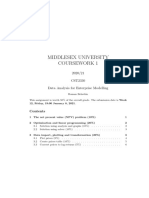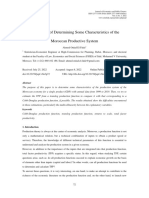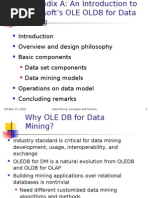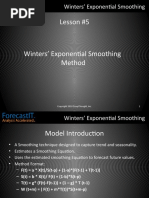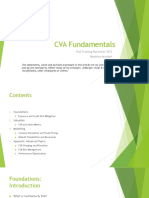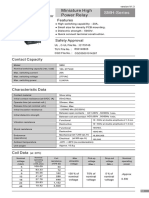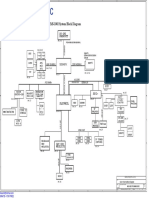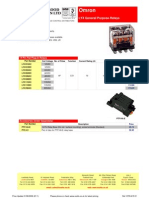Risk Bayes
Risk Bayes
Uploaded by
guliguruCopyright:
Available Formats
Risk Bayes
Risk Bayes
Uploaded by
guliguruOriginal Title
Copyright
Available Formats
Share this document
Did you find this document useful?
Is this content inappropriate?
Copyright:
Available Formats
Risk Bayes
Risk Bayes
Uploaded by
guliguruCopyright:
Available Formats
ML and Model Risk in Finance
Samuel N. Cohen
University of Oxford and Alan Turing Institute
with Christoph Reisinger and Victor Wang
and Lukasz Szpruch and Derek Snow
Doesn’t machine learning free us from needing models?
16 March 2021 ML and Model Risk 2
Modelling and machine learning
▶ Machine learning provides great modelling flexibility
▶ Neural networks / tree based models / Kernel methods all are
tools for expressivity in approximating functions
▶ How we use these methods, and how we make them interact
with data, is a modelling decision.
▶ The results of these methods have hidden assumptions.
16 March 2021 ML and Model Risk 3
An example application
▶ Risk calculation needs models (under real world probabilities)
of risky outcomes.
▶ Options contain useful information, which may not be in basic
prices.
▶ Estimating risks of option portfolios is useful.
Index price
10000 EURO STOXX 50
DAX
5000
2 4 6 8 0 2 4 6 8
200 200 200 200 201 201 201 201 201
1M ATM call option price (normalised)
0.1
EURO STOXX 50
DAX
0.0
2 4 6 8 0 2 4 6 8
200 200 200 200 201 201 201 201 201
16 March 2021 ML and Model Risk 4
Let’s build a model!
▶ We have a collection of inputs
▶ Historical prices of the underlying index
▶ Historical prices of vanilla options
▶ We have desired outputs
▶ Price changes
▶ Hedging strategies
▶ Distributions of losses, value at risk
Data ML Algorithm Risk assessment
16 March 2021 ML and Model Risk 5
A more realistic pipeline
Data Models Outputs Neural Network
Traditional
Generator
Real Data-driven Price
Inputs
Simulated Handcrafted Volatility Outputs
Hybrid Hedging Strategy
Numerical Risk Assessments
Numerical
Environment Optimisation
We will discuss risks in each of these three columns.
16 March 2021 ML and Model Risk 6
Risks from data
Biased Data
▶ Backward looking.
▶ Spurious Correlations.
▶ Sample disparity (e.g. geographic bias).
▶ Imbalanced and insufficient data.
16 March 2021 ML and Model Risk 7
Risks from data
Errors and preprocessing
▶ Recording errors.
▶ Timing errors.
▶ Inconsistent data
▶ Heavy tails
Static arbitrage violations for CME traded USDEUR option EOD prices
2008–2018
16 March 2021 ML and Model Risk 8
Potential Solutions
▶ Domain knowledge – finance is not image processing!
▶ Common methodology and standardized test cases
▶ Synthetic data for quantity and bias correction
▶ Market simulation
▶ 80% of a data scientist’s time is spent on data preparation.
16 March 2021 ML and Model Risk 9
Example solutions
We have a toolbox to identify and remove arbitrage from
historic data (github.com/vicaws/arbitragerepair)
Major currencies Major currencies
75 AUDUSD 200 GBPUSD
EURUSD USDCAD
50 USDCHF
100
25 USDJPY
0 0
2008 2010 2012 2014 2016 2018 2008 2010 2012 2014 2016 2018
Time Time
Cross currencies Emerging market currencies
750
EURGBP USDBRL
100
USDKRW
500
USDMXN
50
250
0 0
2008 2010 2012 2014 2016 2018 2008 2010 2012 2014 2016 2018
Time Time
OTC Forex options on Bloomberg
16 March 2021 ML and Model Risk 10
Example solutions
If considering intraday data, the problem is even worse.
100
N ε,δ
ATM IV
0.35
N ε,δ
50
ATM IV 0.30
0
1.0%
3040
Futures prices
0.5%
Return
3020
0.0%
15min return (positive)
3000
Futures prices 15min return (negative) -0.5%
12:00 13:00 14:00 15:00 16:00
Time (Eastern Time)
12 June 2020, Emini S&P500 monthly European call options, 1 min resolution.
N ϵ,δ =#perturbations outside bid–ask spread needed to eliminate arbitrage.
16 March 2021 ML and Model Risk 11
Example solutions
Synthetic data
▶ Classical models have well understood performance.
▶ They allow us to use our experience in building models.
▶ We can also consider counterfactuals.
▶ Testing models on synthetic data is critical.
16 March 2021 ML and Model Risk 12
Risks from models and methods
Four typical sources of model risk:
▶ Structural risk
▶ Adversarial attack
▶ Sensitivity
▶ Model drift
16 March 2021 ML and Model Risk 13
Model risk – Structural
▶ ML can be misleading in surprising ways
▶ Model richness is constrained by numerical methods, rather
than explicit modelling choices
▶ The questions we ask often hide modelling assumptions
▶ Prediction set – Markov assumption
▶ Summed quadratic loss – no-correlation assumption
▶ Data driven using historical data – no market impact
16 March 2021 ML and Model Risk 14
Model risk – Structural
How we parameterize our models can be suprisingly important
1.0
0.8
0.6
t
t=T
0.4
0.2 K = 1.05
K = 1.1
K = 1.3
0.0 Traded strikes
0.15 0.10 0.05 0.00 0.05 0.10 0.15
mt = ln(K/Ft(T))
CME EURUSD options with expiry 6 March 2020 from first listing
16 March 2021 ML and Model Risk 15
Model risk – Structural
For our EuroSTOXX50 options model
G0 G1 G2
7.5 1
0.2 5.0
2.5 0
0.1
2 2 2
1 1 1
−0.2 0.0 −0.2 0.0 −0.2 0.0
τ
τ
0.2 0 0.2 0 0.2 0
m m m
G3 G4 G5
5 1 0.5
0 0.0
0
−1 −0.5
−5
2 2 2
1 1 1
−0.2 0.0 −0.2 0.0 −0.2 0.0
τ
τ
0.2 0 0.2 0 0.2 0
m m m
16 March 2021 ML and Model Risk 16
Model risk – Adversarial
▶ Arbitrage is a classic adversarial attack
▶ Dynamic and static arbitrage are different
0.10
0.05
ξ2
0.00
−0.05
−0.02 0.00 0.02 0.04 0.06 0.08 0.10
ξ1
16 March 2021 ML and Model Risk 17
Model risk – Sensitivity
▶ Performance depends on a wide range of inputs
▶ These are an opaque form of model selection
2500 2500
Benchmark Benchmark
0 NN depth = 2 0 NN width = 64
NN depth = 5 NN width = 512
−2500 −2500
−5000 −5000
0 5000 10000 15000 20000 0 5000 10000 15000 20000
Epochs Epochs
2500
Benchmark Benchmark
0 Sparsity ratio = 0 Activation = tanh
0
Sparsity ratio = 0.9 Activation = softmax
−2500 −2500
−5000 −5000
0 5000 10000 15000 20000 0 5000 10000 15000 20000
Epochs Epochs
16 March 2021 ML and Model Risk 18
Risk in outputs
▶ We learn a model for the drift and diffusion of the first
two factors, ensuring no static arbitrage
▶ Remaining factors are fitted as independent OU processes
0.06
0.04
0.02
ξ2
0.00
−0.02
−0.02 0.00 0.02 0.04 0.06 0.08
ξ1
Drift Diffusion
0.06 0.06
0.04 0.04
0.02 0.02
ξ2
ξ2
0.00 0.00
−0.02 −0.02
−0.02 0.00 0.02 0.04 0.06 0.08 −0.02 0.00 0.02 0.04 0.06 0.08
ξ1 ξ1
16 March 2021 ML and Model Risk 19
Risk in outputs
▶ The most fundamental risk is that a model will not calibrate
correctly, so ensuring output appears plausible is of first
importance.
▶ A good model should replicate the full range of observed data,
particularly when observed from directions which were not
used in training.
16 March 2021 ML and Model Risk 20
Risk in outputs – Plausible outputs
Implied Volatility surfaces
DAX 2002-05-29 DAX 2017-07-18 ES50 2008-10-17 ES50 2010-07-29
0.27 0.32
0.24
0.26
0.7 0.30
0.22
0.25
0.20 0.28
Implied volatility
Implied volatility
Implied volatility
Implied volatility
Real 0.24
0.18
0.6
0.26
0.23
data 0.22
0.16 0.5
0.24
0.14
0.21 0.4 0.22
0.12
0.20
0.3 0.20
0.10
−0.2 0.0 0.2 −0.2 0.0 0.2 −0.2 0.0 0.2 −0.2 0.0 0.2
Moneyness m Moneyness m Moneyness m Moneyness m
0.27 0.24 0.32
0.65
0.26 0.22 0.30
0.60
0.25 0.20
0.55
Implied volatility
Implied volatility
Implied volatility
0.28
Implied volatility
0.24 0.18
0.50
0.26
0.23 0.16
0.45
Simulation 0.22 0.14
0.40
0.24
0.12
0.21 0.22
0.35
0.10
0.20
−0.2 0.0 0.2 −0.2 0.0 0.2 −0.2 0.0 0.2 −0.2 0.0 0.2
Moneyness m Moneyness m Moneyness m Moneyness m
16 March 2021 ML and Model Risk 21
Risk in outputs – VIX
Volatility index calculated from CBOE VIX methodology
40
Real 20
data 0 1000 2000 3000 4000
Log-return of S
0.1
0.0
0 1000 2000 3000 4000
Time
Volatility index calculated from CBOE VIX methodology
30
20
10
0 1000 2000 3000 4000 5000
Simulation Log-return of S
0.0
−0.1
0 1000 2000 3000 4000 5000
Time
16 March 2021 ML and Model Risk 22
Risk in outputs – VIX
EURO STOXX 50 index options
0.04
Data
0.03 Real
Simulation
Log-return of S 0.02
0.01
0.00
−0.01
−0.02
−0.03
−0.04
10 20 30 40
Volatility index
16 March 2021 ML and Model Risk 23
Performance and Risk
▶ Given ML models are less explainable than traditional
approaches, they are only worthwhile if they result in a
performance gain.
▶ Performance can be measured both in terms of statistical fit
and predictive power, and in terms of reducing computational
cost
▶ Generally, ML methods will be much more expensive to train,
but may be cheaper to run.
16 March 2021 ML and Model Risk 24
Value at Risk
▶ We can use our model to compute risk profiles for various
options portfolios.
▶ Outright calls and Delta-hedged calls
▶ Delta spreads, Delta butterflies, Delta-neutral strangles
▶ Risk reversal, Calendar spreads, VIX
▶ We use the historical innovations (to allow for unmodelled and
higher-order correlation effects) from our training data
▶ For comparison, we also use a Filtered Historical Simulation
approach, from a time-series model on the Heston parameters.
▶ Given the neural-SDE approach does not involve additional
option pricing, it is much more computationally efficient.
16 March 2021 ML and Model Risk 25
1-day 0.99-Value at Risk
Neural-SDE Heston-EWMA FHS
Coverage ratio median 0.9921 0.9881
Coverage ratio mean 0.9887 0.9742
Kupiec PF (two-sided) 6.92% 25.23%
Kupiec PF (one-sided) 6.92% 25.23%
Christoffersen independence 0.70% 11.03%
Conditional coverage 3.53% 24.88%
Basel committee traffic light 69.1% 29.7% 0.5% 62.4% 25.9% 10.8%
16 March 2021 ML and Model Risk 26
1-day 0.99-Value at Risk
Long Short
Outright
Delta spread
Risk reversal
Long S Short S
VaR (long)
50 50
Realised PnL
0 0
−50 −50
VaR (short)
Realised PnL
−100 −100
2019-01-02 2019-03-13 2019-05-27 2019-08-05 2019-10-14 2019-12-23 2019-01-02 2019-03-13 2019-05-27 2019-08-05 2019-10-14 2019-12-23
Date Date
16 March 2021 ML and Model Risk 27
1-day 0.99-Value at Risk
Long Short
Delta butterfly
Delta-hedged option
Delta-neutral strangle
Calendar spread
Long VIX Short VIX
10 10
VaR (long)
5 Realised PnL
0 0
−5
−10 −10 VaR (short)
2019-01-02 2019-03-13 2019-05-27 2019-08-05 2019-10-14 2019-12-23 2019-01-02 2019-03-13 2019-05-27 2019-08-05 2019-10-14 2019-12-23
Date Date
16 March 2021 ML and Model Risk 28
1-day 0.99-Value at Risk (training sample)
300 VaR (long)
VaR (short)
200
Realised PnL
100
−100
−200
−300
2002-01-02 2006-01-09 2009-12-22 2013-11-21 2017-10-30
16 March 2021 ML and Model Risk 29
1-day 0.99-Value at Risk – procyclicality
1-day VaR0.99
Number of trading strategy
150 Neural-SDE
FHS
100
50
0
0.0 0.2 0.4 0.6 0.8
Trough-to-Peak ratio (1.0 = constant VaR)
16 March 2021 ML and Model Risk 30
1-day 0.99-Value at Risk – computational time
Simulate & revaluation Repair arbitrage
nSDE FHS (Heston) nSDE FHS (Heston)
Expected time (ms) 5.0 147.3 14.3 N.A.
Std. time (ms) 0.3 58.7 7.1 N.A.
Table: Average and standard deviation of the elapsed time for simulation
one risk scenario.
16 March 2021 ML and Model Risk 31
Conclusions
▶ ML is a powerful numerical tool, and gives flexible modelling
▶ Risk management still requires expert knowledge
▶ Benchmarking and testing critical
▶ Explainability and monitoring remains a challenge
▶ Potential benefits mean it’s certainly worth pursuing!
16 March 2021 ML and Model Risk 32
References
▶ SNC, C Reisinger, S Wang, Detecting and repairing arbitrage
in traded option prices, App Math Fin, 2021
(arXiv:2008.09454)
▶ SNC, C Reisinger, S Wang, Arbitrage-free neural-SDE market
models, 2021 (arXiv:2105.11053)
▶ SNC, C Reisinger, S Wang, Estimating risks of option books
using neural-SDE market models, 2022 (arXiv:2202.07148)
▶ SNC, D Snow, L Szpruch, Black-box model risk in finance,
2021, in Machine Learning and Data Science in Financial
Markets (to appear) (arXiv:2102.04757)
16 March 2021 ML and Model Risk 33
You might also like
- 动态对冲 管理普通期权与奇异期权 PDFDocument460 pages动态对冲 管理普通期权与奇异期权 PDFguliguruNo ratings yet
- SOP Manual Rev 24 2 - FlattenedDocument186 pagesSOP Manual Rev 24 2 - Flattenedsinusake90% (10)
- Acme Risk PlanDocument22 pagesAcme Risk PlanCarlos GuachaminNo ratings yet
- Lean Construction 4.0 - Driving A Digital RevolutionDocument373 pagesLean Construction 4.0 - Driving A Digital RevolutionRAFAEL HUMBERTO SANCHEZ SILVANo ratings yet
- Trend of Netflix's Streaming Subscribers Worldwide in Nine Years From 2011-2020Document7 pagesTrend of Netflix's Streaming Subscribers Worldwide in Nine Years From 2011-2020Minh Thu NguyenNo ratings yet
- Middlesex University Coursework 1: 2020/21 CST2330 Data Analysis For Enterprise ModellingDocument8 pagesMiddlesex University Coursework 1: 2020/21 CST2330 Data Analysis For Enterprise ModellingZulqarnain KhanNo ratings yet
- CH 18Document1,901 pagesCH 18DavidNo ratings yet
- CH 19Document3,760 pagesCH 19DavidNo ratings yet
- ML Assignment - 2Document2 pagesML Assignment - 2Aswin RajNo ratings yet
- 50 Year and COVID-19Document39 pages50 Year and COVID-19Pretty SweetNo ratings yet
- Week 6 - Data Mining For BIDocument34 pagesWeek 6 - Data Mining For BIManzur AshrafNo ratings yet
- Question Bank - PADocument3 pagesQuestion Bank - PAkisu84127No ratings yet
- CH 17Document2,828 pagesCH 17DavidNo ratings yet
- 07 Production and CostsDocument6 pages07 Production and CostsJohn Williever GonzalezNo ratings yet
- SCOM PPT 1-NewDocument16 pagesSCOM PPT 1-Newshreya rastogiNo ratings yet
- Synthesis DistributedDocument77 pagesSynthesis DistributedravishopingNo ratings yet
- Apple, Microsoft, Amazon and Google - A Correlation Analysis: Evidence From A DCC-GARCH ModelDocument14 pagesApple, Microsoft, Amazon and Google - A Correlation Analysis: Evidence From A DCC-GARCH ModelramyNo ratings yet
- Article Publié #2-2022 Mois 8 12Document10 pagesArticle Publié #2-2022 Mois 8 12Ahmed OULAD EL FAKIRNo ratings yet
- 2020F Assignment #2 (Cover Page) - 2Document5 pages2020F Assignment #2 (Cover Page) - 2mamadou17diallo17No ratings yet
- Cisco Live Technology PresentationDocument67 pagesCisco Live Technology PresentationAndre FosterNo ratings yet
- Time Series DecompositionDocument54 pagesTime Series DecompositionAman SaxenaNo ratings yet
- Winter 2012Document4 pagesWinter 2012shyam1985No ratings yet
- Appendix ADocument21 pagesAppendix Aapi-27259648No ratings yet
- 8.4 Example: Swiss Market Index (SMI) : 188 8 Models of VolatilityDocument3 pages8.4 Example: Swiss Market Index (SMI) : 188 8 Models of VolatilityNickesh ShahNo ratings yet
- Chapter 6Document47 pagesChapter 6Dishi ParekhNo ratings yet
- Review - StationarityDocument56 pagesReview - StationarityKhánh Đoan Lê ĐìnhNo ratings yet
- INTC Investment ReportDocument1 pageINTC Investment ReportkhoocheeweeNo ratings yet
- Tutorial 5 - Bivariate AnalysisDocument7 pagesTutorial 5 - Bivariate AnalysisNoorNabilaNo ratings yet
- Bodie Investments 13e PPT CH08 StudentDocument53 pagesBodie Investments 13e PPT CH08 Studentj9292kimoNo ratings yet
- Forecast It 5. Winters' Exponential SmoothingDocument14 pagesForecast It 5. Winters' Exponential SmoothingForecastITNo ratings yet
- Lec 05 - Arithmetic CodingDocument44 pagesLec 05 - Arithmetic CodingperhackerNo ratings yet
- 2024 03 04 Mebe Lecture5 NopollDocument78 pages2024 03 04 Mebe Lecture5 NopollsanderbunkNo ratings yet
- Cryptoassets: The Financial MetaverseDocument125 pagesCryptoassets: The Financial MetaverseTom ChoiNo ratings yet
- Handwritten Digit Recognition with ML ModelsDocument41 pagesHandwritten Digit Recognition with ML Modelskrishnan5307tradingNo ratings yet
- CH 23Document1,409 pagesCH 23DavidNo ratings yet
- Jain College, Bangalore Mock Paper - 1, January - 2017 II PUC - StatisticsDocument6 pagesJain College, Bangalore Mock Paper - 1, January - 2017 II PUC - Statisticsprasadkh90No ratings yet
- Footwearindustryofbangladesh AwayforwardDocument39 pagesFootwearindustryofbangladesh AwayforwardArup ChakrabortyNo ratings yet
- 50 AAPL Buyside PitchbookDocument22 pages50 AAPL Buyside PitchbookmajorkonigNo ratings yet
- The Future of Passenger Data A Journey or A Destination IATA, Aviation Data Symposium, Miami (PDFDrive)Document92 pagesThe Future of Passenger Data A Journey or A Destination IATA, Aviation Data Symposium, Miami (PDFDrive)tediNo ratings yet
- Data Visualisation: Module 3 Week 8 INFOSYS 110 Digital SystemsDocument48 pagesData Visualisation: Module 3 Week 8 INFOSYS 110 Digital SystemsGiezel MadurarNo ratings yet
- Static and Dynamic Input-Output Modelling With Microsoft ExcelDocument42 pagesStatic and Dynamic Input-Output Modelling With Microsoft ExcelGabriel Rios DiazNo ratings yet
- Machine LearningDocument28 pagesMachine LearningkamalshrishNo ratings yet
- De Lecture 5Document50 pagesDe Lecture 5quynh11b8No ratings yet
- Interest Rate Model Selection - LevinDocument13 pagesInterest Rate Model Selection - LevinvansteeNo ratings yet
- Revenue 3.4 4.3 12.9 21.0 24.3: Particulars (INR CR) Q4 FY24 Q1 FY25 Q2 FY25 Q3 FY25 Q4 FY25Document95 pagesRevenue 3.4 4.3 12.9 21.0 24.3: Particulars (INR CR) Q4 FY24 Q1 FY25 Q2 FY25 Q3 FY25 Q4 FY25Ankit GargNo ratings yet
- Class 5 Risk and Return FULL VERSIONDocument4 pagesClass 5 Risk and Return FULL VERSIONdbokishevNo ratings yet
- LondonR - R in Actuarial Analysis - Chibisi Chima-Okereke - 20111206Document40 pagesLondonR - R in Actuarial Analysis - Chibisi Chima-Okereke - 20111206DasioNo ratings yet
- Study Id59297 Artificial-Intelligence-Ai PDFDocument99 pagesStudy Id59297 Artificial-Intelligence-Ai PDFRishi KumarNo ratings yet
- 2a. Exploratory Data AnalysisDocument7 pages2a. Exploratory Data AnalysisNAVEEN KUMAR MISHRANo ratings yet
- ASRS Data Analysis v1.0Document13 pagesASRS Data Analysis v1.0Aditya TomarNo ratings yet
- 50 AAPL Buyside PitchbookDocument22 pages50 AAPL Buyside PitchbookkamranNo ratings yet
- VLB KBW Note 10 December 2010 AmendedDocument31 pagesVLB KBW Note 10 December 2010 AmendedrkformNo ratings yet
- Cropped - Industrial Investment Opportunities in SECDocument94 pagesCropped - Industrial Investment Opportunities in SECAmin AzadNo ratings yet
- Economics AssignDocument3 pagesEconomics Assigncacious mwewaNo ratings yet
- Numeric Modelling With The Wolf Pass Project: For Leapfrog Geo Version 5.1Document80 pagesNumeric Modelling With The Wolf Pass Project: For Leapfrog Geo Version 5.1Bayartsengel TseNo ratings yet
- Coincharted Pre-Seed Pitch Deck V9Document12 pagesCoincharted Pre-Seed Pitch Deck V9z.fikar10aliNo ratings yet
- Walmart (Project)Document46 pagesWalmart (Project)bh.rautelaNo ratings yet
- Inferential StatisticsDocument10 pagesInferential StatisticsSapana SonawaneNo ratings yet
- 2024SDSC500AD AssignmentDocument24 pages2024SDSC500AD AssignmentValentinoNo ratings yet
- 00 IntroductionDocument27 pages00 Introductionleagueoflegendsbeta1999No ratings yet
- Location Planning and Analysis: Mcgraw-Hill/IrwinDocument25 pagesLocation Planning and Analysis: Mcgraw-Hill/IrwintayerNo ratings yet
- Data Description and Visualization Workshop - Data Visualization Real SpiritDocument7 pagesData Description and Visualization Workshop - Data Visualization Real SpiritZoya AhmadNo ratings yet
- Analitik Data Dalam BisnisDocument52 pagesAnalitik Data Dalam Bisnissabrina hakimNo ratings yet
- Evaluating Hedge Fund and CTA Performance: Data Envelopment Analysis ApproachFrom EverandEvaluating Hedge Fund and CTA Performance: Data Envelopment Analysis ApproachNo ratings yet
- CN - Complete NotesDocument335 pagesCN - Complete NotesguliguruNo ratings yet
- Fund2vec PAPERDocument8 pagesFund2vec PAPERguliguruNo ratings yet
- Scoleri Chebyshev GreeksDocument40 pagesScoleri Chebyshev GreeksguliguruNo ratings yet
- Nyu Pde PRESENTATIONDocument101 pagesNyu Pde PRESENTATIONguliguruNo ratings yet
- Xva - Ma - D1S1Document30 pagesXva - Ma - D1S1guliguruNo ratings yet
- Barclays A Guide To MBS ReportsDocument33 pagesBarclays A Guide To MBS ReportsguliguruNo ratings yet
- Module1 LecturesDocument103 pagesModule1 LecturesguliguruNo ratings yet
- Pru HQ CMBS Value of Structure 7 10Document12 pagesPru HQ CMBS Value of Structure 7 10guliguruNo ratings yet
- Valuation and Modeling ServicesDocument2 pagesValuation and Modeling ServicesguliguruNo ratings yet
- Narrative Report 2018Document2 pagesNarrative Report 2018Judy Ann BoseNo ratings yet
- Rigging and Deck GearDocument248 pagesRigging and Deck Gearswapneel_kulkarni100% (2)
- PATHFit 4.mountaineeringDocument7 pagesPATHFit 4.mountaineeringjhonreyreman2000No ratings yet
- 2018 Ateneo SOC Political Law Oct 8 2018 Candelaria PDFDocument33 pages2018 Ateneo SOC Political Law Oct 8 2018 Candelaria PDFjohn goNo ratings yet
- PG Physics 2010 2011 PDFDocument32 pagesPG Physics 2010 2011 PDFHemant SinghNo ratings yet
- Sanyou Relays: Miniature High Power RelayDocument3 pagesSanyou Relays: Miniature High Power RelayTV Cinaqui ContiNo ratings yet
- MSI MEGABOOK L610i - MS-1002 - REV 0C - 2Document44 pagesMSI MEGABOOK L610i - MS-1002 - REV 0C - 2Edson HenriqueNo ratings yet
- Latch Up Failure in IGBTDocument3 pagesLatch Up Failure in IGBTgetssyNo ratings yet
- Resume - Mohammadreza Nikzad JamnaniDocument3 pagesResume - Mohammadreza Nikzad Jamnanimohammadrezahajian12191No ratings yet
- RF MEMS Switches and Switch Circuits: Shimul Chandra SahaDocument174 pagesRF MEMS Switches and Switch Circuits: Shimul Chandra SahaRajNo ratings yet
- Aics9e PPT 8 5Document25 pagesAics9e PPT 8 5beverly p cadacioNo ratings yet
- 1.2 Factors Impacting International Business OperationsDocument37 pages1.2 Factors Impacting International Business OperationsCharles TuazonNo ratings yet
- Catalog 26 C1020CEDocument94 pagesCatalog 26 C1020CEPetru AncaNo ratings yet
- Omron: LY4 General Purpose RelaysDocument1 pageOmron: LY4 General Purpose Relaysvnnghia_bkNo ratings yet
- Poarta Culisanta Curte Comat - SalajDocument32 pagesPoarta Culisanta Curte Comat - SalajOana MunteanuNo ratings yet
- Tue Class (Retail Banking)Document16 pagesTue Class (Retail Banking)Harendra Singh BhadauriaNo ratings yet
- Letter of Appointment: ACTED HR Manual - National StaffDocument1 pageLetter of Appointment: ACTED HR Manual - National Staffhassan kaafiNo ratings yet
- Nonstandard Career Trajectories and Their VariousDocument25 pagesNonstandard Career Trajectories and Their VariousGABRIELA SUZETTE TITO RUIZNo ratings yet
- Delivery Challan# INV-17Document2 pagesDelivery Challan# INV-17hemantrulzNo ratings yet
- Caged SlaveDocument77 pagesCaged SlaveAlexandra Tofan100% (2)
- Company Profile ProjectDocument5 pagesCompany Profile Projectjaelle moNo ratings yet
- Bank Swift CodeDocument6 pagesBank Swift CodeYew HongNo ratings yet
- If I Was The President of Uganda by Isaac Christopher LubogoDocument69 pagesIf I Was The President of Uganda by Isaac Christopher LubogolubogoNo ratings yet
- Facilities Management: Risk Assessment Cable PullingDocument1 pageFacilities Management: Risk Assessment Cable PullingMariam BakariNo ratings yet
- Draft Guidance For Industry and FDA Staff Processing/Reprocessing Medical Devices in Health Care Settings: Validation Methods and LabelingDocument38 pagesDraft Guidance For Industry and FDA Staff Processing/Reprocessing Medical Devices in Health Care Settings: Validation Methods and Labelingjonh366No ratings yet
- 08 Runout & ProfileDocument22 pages08 Runout & Profilemaddy_scribdNo ratings yet
- The Slit Needleless Electrode For The ElectrospinningDocument6 pagesThe Slit Needleless Electrode For The ElectrospinningnoelNo ratings yet





